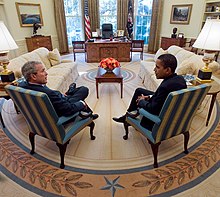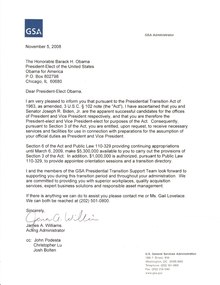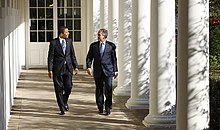
A | B | C | D | E | F | G | H | CH | I | J | K | L | M | N | O | P | Q | R | S | T | U | V | W | X | Y | Z | 0 | 1 | 2 | 3 | 4 | 5 | 6 | 7 | 8 | 9
 Outgoing President George W. Bush (left) and President-elect Barack Obama (right) meet in the Oval Office of the White House as part of the presidential transition | |
| Date of election | November 4, 2008 |
|---|---|
| Inauguration date | January 20, 2009 |
| President-elect | Barack Obama (Democrat) |
| Vice president-elect | Joe Biden (Democrat) |
| Outgoing president | George W. Bush (Republican) |
| Outgoing vice president | Dick Cheney (Republican) |
| Headquarters | Chicago, Illinois and Washington, D.C. |
Executive Director | Chris Lu |
Budget | $12 million |
Staff | 450 |
| Website | http://change.gov/ [dead link] |
The presidential transition of Barack Obama began when he won the United States presidential election on November 4, 2008, and became the president-elect. Obama was formally elected by the Electoral College on December 15, 2008. The results were certified by a joint session of Congress on January 8, 2009, and the transition ended when Obama was inaugurated at noon EST on January 20, 2009.[1][2]
| ||
|---|---|---|
| Transitions | ||
Planned transitions
|
||
| Related | ||
| ||
|---|---|---|
|
Pre-presidency 44th President of the United States First term Second term Post-presidency Publications Personal  |
||
Organization of the transition

The Obama transition organization was called the Obama-Biden Transition Project.[3] The transition team was convened during the height of the campaign, well before the outcome could be known, to begin making preparations for a potential administration. It was co-chaired by John Podesta, who was Bill Clinton's fourth and last White House chief of staff and the president/chief executive officer of the Center for American Progress,[4] Valerie Jarrett, who is one of Obama's longest-serving advisers,[5][6] and Pete Rouse, former Senate chief of staff for Tom Daschle who succeeded Rahm Emanuel as Obama's chief of staff.[7]
On November 5, the General Services Administration declared that Obama was the "apparent winner," making him eligible to receive transition funding and other government services, and granting him access to their 2008 presidential transition headquarters in Washington, D.C.[8] Podesta estimated that the transition would employ approximately 450 people and have a budget of about $12 million: $5.2 million would be paid by the federal government and the remaining $6.8 million would be funded by private sources, with each contribution limited to $5,000. The transition project would not accept money from political action committees or federal lobbyists.[9]
Transition team
On November 5, Obama announced his complete transition team, which was organized as a nonprofit tax-exempt organization under U.S. federal tax code 501(c)(4). The advisory board consisted of Carol Browner, William M. Daley, Christopher Edley, Michael Froman, Julius Genachowski, Donald Gips, Janet Napolitano, Federico Peña, Susan Rice, Sonal Shah, Mark Gitenstein and Ted Kaufman.[10]

Members of the transition team's senior staff included:[10]
- Chris Lu – Executive Director
- Dan Pfeiffer – Communications Director
- Stephanie Cutter – Chief Spokesperson
- Robert Gibbs - Press Secretary[11]
- Cassandra Butts – General Counsel
- Jim Messina – Personnel Director
- Patrick Gaspard – Associate Personnel Director
- Christine A. Varney - Personnel Counsel
- Melody Barnes – Co-director of Agency Review
- Lisa Brown – Co-director of Agency Review
- Phil Schiliro – Director of Congressional Relations
- Michael Strautmanis – Director of Public Liaison and Intergovernmental Affairs
- Katy Kale – Co-director of Operations
- Brad Kiley – Co-director of Operations
Joshua Gotbaum and Michael Warren headed the transition team of the Treasury Department. In addition, Thomas Donilon and Wendy Sherman oversaw the transition of the State Department. Seth Harris oversaw the transition in all of the labor, education, and transportation agencies with Edward B. Montgomery leading the Labor Department agency review team, Mortimer Downey leading the Transportation Department agency review team, and Judith Sherman leading the Education Department agency review team. Finally, John P. White and Michele Flournoy led the transition of the Defense Department.[12]
Activities as the president-elect
Bush administration


In mid-October, the George W. Bush administration convened a fourteen-member council to coordinate with and brief the winning campaign's transition team.[5] The New York Times reported that White House chief of staff Joshua Bolten then planned to recruit his predecessor, Andrew Card, to oversee the activity.[5] On November 6, Obama received his first classified intelligence briefing from director of national intelligence John Michael McConnell and Central Intelligence Agency director Michael Hayden.[13]
President Bush invited Obama and his team to attend the 2008 G-20 Washington summit held between November 15 and 20 in order to introduce him to more than twenty world leaders who attended the event. However, Obama did not come, and his transition team instead sent former Republican Rep. Jim Leach and former Secretary of State Madeleine Albright to meet with the heads of state.[14][15] Obama was expected to address a United Nations global warming summit in Poland in December or allow a representative such as Al Gore to present his policies.[4]
On November 10, Obama traveled to the White House and met with President Bush to discuss transition issues while First Lady Laura Bush took his wife Michelle on a tour of the mansion. NBC News reported that Obama advanced his economic agenda with Bush, asking him to attempt to pass a stimulus package in a lame duck session of Congress before the inauguration. He also urged Bush to accelerate the disbursement of $25 billion in funds to bail out the automobile industry and expressed concern about additional Americans losing their homes as mortgage rates increase again.[16][17]
The Bush administration reportedly went out of its way to make the transition as seamless as possible for the incoming administration, earning accolades from Obama staff members and outside experts alike. According to nearly all accounts, the Bush administration streamlined the process for new officials to obtain security clearances and planned training exercises for the incoming national security team, to ensure that they would be ready to face a possible crisis on the first day in office. Part of this enhanced cooperation is required by laws passed at the behest of the 9/11 Commission, while part is attributed to the difficulty that the Bush administration had with its own transition, which lasted only five weeks and was felt to have had a deleterious effect on Bush's ability to govern. "I'm not sure I've ever seen an outgoing administration work as hard at saying the right thing," said Stephen Hess of the Brookings Institution. "This is really quite memorable."[18]
During the transition, the Bush administration had many important matters to address, even as a lame duck president. There was an ongoing financial crisis,[19] and this was the first presidential transition since the presidential transition of Richard Nixon to occur while the United States was at war.[20]
Resignation from Senate offices
At the time of their election, President-elect Obama and Vice President-elect Joseph Biden were incumbent U.S. senators from Illinois and Delaware respectively. In accordance with Article I, Section 6 of the United States Constitution, both were required to resign their respective Senate seats on or before January 20, 2009, in order to become president and vice president.
Obama Senate transition

Obama resigned from the Senate effective November 16, 2008.[21][22] Initially, it was thought that his replacement would be named by Illinois Governor Rod Blagojevich. Since the term for the seat expired in January 2011, it would come up for its normal election in 2010 with no special election necessary. Blagojevich was expected to name Obama's immediate successor in the Senate by January 3, 2009.[23] However, on December 9, 2008, the status of Obama's succession in the Senate was cast in doubt after Blagojevich was arrested on federal corruption charges, which included allegedly attempting to sell the appointment.[24] Although placed in federal custody and released on $4,500 bail,[25] as long as he remained governor Blagojevich continued to have sole authority to make the appointment.[26] Several Democrats, including Sen. Dick Durbin, asked the Illinois General Assembly to schedule a special election instead.[27]
Speaking through a surrogate, Obama called for Blagojevich's resignation on December 10.[28] Had Blagojevich resigned or been removed from office before making the appointment, the duty would have fallen to Illinois Lt. Gov. Pat Quinn, who would succeed Blagojevich as governor. However, Illinois Senate president Emil Jones said that he would call the Senate back into session to write a law that would result in Obama's replacement being determined in a special election.[29]
However, after the state legislature did not pass a law mandating a special election for the seat, on December 30, Blagojevich announced that he was appointing Roland Burris, a former Illinois Attorney General, Illinois Comptroller, and U.S. Treasury Department official, to the seat, citing his constitutional duty in the absence of a law requiring a special election.[30] Blagojevich, Burris, and Representative Bobby Rush urged the public to consider the qualifications of Burris as a public servant and not the scandals in which Blagojevich was embroiled.[31]
However, the Senate Democrats released a statement in which they reaffirmed that they would refuse to seat anyone appointed to the seat by Blagojevich, as that individual would be an ineffective representative of Illinois because of "questions of impropriety."[32]
Some members of the Congressional Black Caucus, including Rush, expressed their support for seating Burris, who would be the only African-American in the Senate; Rush compared a Senate rejection of Burris to a lynching.[33] However, President-elect Obama released a statement condemning the appointment and again calling on Blagojevich to resign.[34] In addition, the Illinois Secretary of State, Jesse White, reiterated that he would not certify any appointment made by Blagojevich, although at the time it was not clear whether this could prevent Burris from taking office.[35] Furthermore, the Senate might not actually have been able to refuse to seat Burris, as he met all constitutional requirements for the office and was not involved in the Blagojevich corruption scandal (per the U.S. Supreme Court decision Powell v. McCormack).[36]
On January 9, 2009, the Illinois Supreme Court ruled in the case Burris v. White that the appointment only required the signature of the governor to be valid, and not that of the Illinois Secretary of State, and that the state of Illinois is not required to use the Senate's recommended certification form, as it is only "recommended" under the Standing Rules of the United States Senate.[37][38] The Court further remarked that "no explanation has been given as to how any rule of the Senate, whether it be formal or merely a matter of tradition, could supersede the authority to fill vacancies conferred on the states by the federal constitution".[39] Following the ruling, White provided Burris with a certified copy of the appointment's registration, and Burris delivered that copy, that bears the State Seal, to the Secretary of the Senate.[40] His credentials declared valid, Burris was finally sworn in on January 15, 2009, by outgoing President of the Senate Dick Cheney.[41][42][43]
Biden Senate transition
Biden had indicated that he would remain in the Senate until he was sworn in as vice president on January 20, 2009.[44] Although he was sworn in for a seventh Senate term in early January 2009, he resigned from the seat on January 15, 2009, having served just over 36 years in the body.[45] He was Delaware's longest-serving senator.
On November 24, 2008, Delaware Gov. Ruth Ann Minner announced that Ted Kaufman would serve as Biden's appointed replacement.[46] Kaufman was sworn in on January 16, 2009.[47] A special election was held in November 2010, which elected Democratic candidate Chris Coons.
During his abbreviated final term in the Senate, Biden went on a diplomatic fact-finding trip to Iraq, Afghanistan, and Pakistan, becoming the first vice-president-elect to undertake such a mission before entering office.[48]
Change.gov website
On November 5, 2008, the transition team launched change.gov, the official website of the transition.[49]
The website included a blog and jobs page.[50] It also had a section that allowed visitors to share stories or their visions for the country.[51] Visitors were able to comment on issues important to them using the Citizen's Briefing Book. Individuals applying for work within the Obama administration via this site were required to go through intensive consumer and criminal background checks performed by the ChoicePoint Corporation.[52] The website used a Creative Commons license.[53]
As part of their efforts towards transparency, on December 5 the transition team announced that "all policy documents from official meetings with outside organizations will be publicly available for review and discussion on Change.gov." After the inauguration, many of the functions of change.gov were transferred to a redesigned White House website.[54]
Administration appointments
Thirty-one of the appointments to the transition team had previously worked in the Clinton administration, including Podesta, chief of staff Rahm Emanuel, and Biden's chief of staff Ron Klain.[55]
Announcements
Obama held near-daily press conferences as president-elect to announce his administration nominees to the public.[56] He introduced the nominees and occasionally took questions from the press regarding issues such as economic difficulties and the war in Afghanistan.[57]
The appointments of Lawrence Summers and Timothy F. Geithner to key economic positions were criticized, on grounds that they had been prominently involved in creating many of the conditions that led to the financial crisis of 2007–2008, so "failure is being rewarded."[58] Summers was a leading advocate of the derivatives deregulation, together with Alan Greenspan and Robert Rubin,[59][60] and during his transition to Secretary of the Treasury, the act that kept commercial banks out of Wall Street, the Glass–Steagall Act, was repealed.[58] Geithner instead was criticized for his failure to pay $34,000 in income taxes.[61]
The appointment of Eric Holder for attorney general raised concerns, due to his role in the last-minute pardon issued by Bill Clinton for fugitive financier Marc Rich.[62]
During his first press conference as president-elect, on November 7, Obama remarked about former first lady Nancy Reagan holding seances in the White House, which gained widespread attention.[63][64][65][66] Termed his "first gaffe,"[67] Obama called Mrs. Reagan later that evening to apologize for what his spokesperson said was a "careless and off-handed remark."[68]
- Chief of staff: Representative Rahm Emanuel of Illinois was selected by President-elect Obama on November 6, two days after the election.[69]
- Deputy Chiefs of Staff: Jim Messina, current director of personnel for the Obama Transition team and former chief of staff to Senator Max Baucus; and Mona Sutphen, a former career foreign service officer who worked for President Clinton's National Security Council.[70]
- Senior Advisors to the President: Campaign strategist David Axelrod[71] and Pete Rouse, who has been serving as Obama's Senate chief of staff.[70]
- Senior Advisor and Assistant to the President for Intergovernmental Relations and Public Liaison: Valerie Jarrett, a lawyer who served as Chicago's planning commissioner and later was chairperson of the Chicago Transit Authority. In 1995, Jarrett left public service to join the Habitat Corporation, a Chicago real estate management company.[72]
- Assistant to the President for Legislative Affairs: Phil Schiliro.[73]
- White House Counsel: Greg Craig.[74]
- Cabinet Secretary: Chris Lu, former legislative director of Obama's Senate office.
- Staff Secretary: Lisa Brown, executive director of the American Constitution Society.[75]
- Press Secretary: Robert Gibbs, announced on November 22.[76]
- Communications Director: Ellen Moran.[76]
- Deputy Director of Communications: Dan Pfeiffer.[76]
- Chair of the White House Council on Environmental Quality: Nancy Sutley, a well-known member of the LGBT community, and Deputy Mayor of Los Angeles.
- Deputy Director of White House Office of Health Reform: Jeanne Lambrew.
- White House photographer: Pete Souza.[77]
Cabinet and top advisors
There was one withdrawal, New Mexico Governor Bill Richardson, whom Obama had named Secretary of Commerce. Richardson's administration was, at the time, the subject of a federal corruption probe; while maintaining that his administration was responsible for no wrongdoing, he withdrew so as to prevent a lengthy confirmation process from hindering the work of the U.S. Department of Commerce.[78] The position was filled by Gary Locke.
Obama named Tim Kaine as new chairman of the Democratic National Committee, replacing Howard Dean who has clashed with Obama and his advisors in the past. Kaine served concurrently as Governor of Virginia until his term ended in January 2010.[79]
Obama named Aneesh Chopra for the new position of Chief Technology Officer of the United States, Vivek Kundra as Chief Information Officer and Jeffrey Zients Chief Performance Officer[80][81] and deputy director for management of the Office of Management and Budget[82]
Initial reaction to Obama's choice of Leon Panetta as CIA director was mixed, with some intelligence professionals expressing concern that Panetta lacked specific intelligence experience,[83] and others such as former Congressman and co-chair of the Iraq Study Group Lee H. Hamilton praising the choice.[84]
Domestic policy
Economic policyedit
-
Lawrence Summers
Assistant to the President for Economic Policy
Director, National Economic Council
(announced November 24, 2008)[93]
Environment and energyedit
-
Ken Salazar
Secretary of the Interior
(announced December 17) (the nomination was given a Saxbe fix)[92][99] -
Carol Browner
Assistant to the President for Energy and Climate Change
(announced December 15, 2008)[102]
Foreign affairs and national securityedit
-
Hillary Clinton
Secretary of State
(announced December 1)[103] (the nomination was given a Saxbe fix)[104][105][106][107][108] -
Robert Gates
Secretary of Defense
(continuation of previous administration's appointment, announced December 1)[103]































